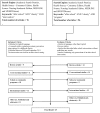After-school based obesity prevention interventions: a comprehensive review of the literature
- PMID: 22690204
- PMCID: PMC3366622
- DOI: 10.3390/ijerph9041438
After-school based obesity prevention interventions: a comprehensive review of the literature
Abstract
The purpose of this article was to review primary prevention interventions targeting childhood obesity implemented in the after school environment from 2006 and 2011. A total of 20 interventions were found from 25 studies. Children in the interventions ranged from kindergarten to middle schoolers, however a majority was in the 4th and 5th grades. Most of the interventions targeted both physical activity and dietary behaviors. Among those that focused on only one dimension, physical activity was targeted more than diet. The duration of the interventions greatly varied, but many were short-term or brief. Many interventions were also based on some behavioral theory, with social cognitive theory as the most widely used. Most of the interventions focused on short-term changes, and rarely did any perform a follow-up evaluation. A major limitation among after school interventions was an inadequate use of process evaluations. Overall, interventions resulted in modest changes in behaviors and behavioral antecedents, and results were mixed and generally unfavorable with regards to indicators of obesity. Recommendations for enhancing the effectiveness of after school based childhood obesity interventions are presented.
Keywords: after school; child obesity; literature review.
Figures
Similar articles
-
School-based interventions for childhood and adolescent obesity.Obes Rev. 2006 Aug;7(3):261-9. doi: 10.1111/j.1467-789X.2006.00227.x. Obes Rev. 2006. PMID: 16866974 Review.
-
Dietary education in school-based childhood obesity prevention programs.Adv Nutr. 2011 Mar;2(2):207S-16S. doi: 10.3945/an.111.000315. Epub 2011 Mar 10. Adv Nutr. 2011. PMID: 22332053 Free PMC article. Review.
-
Reducing obesity and related chronic disease risk in children and youth: a synthesis of evidence with 'best practice' recommendations.Obes Rev. 2006 Feb;7 Suppl 1:7-66. doi: 10.1111/j.1467-789X.2006.00242.x. Obes Rev. 2006. PMID: 16371076 Review.
-
Effective strategies for childhood obesity prevention via school based, family involved interventions: a critical review for the development of the Feel4Diabetes-study school based component.BMC Endocr Disord. 2020 May 6;20(Suppl 2):52. doi: 10.1186/s12902-020-0526-5. BMC Endocr Disord. 2020. PMID: 32370795 Free PMC article. Review.
-
School-based approaches for preventing and treating obesity.Int J Obes Relat Metab Disord. 1999 Mar;23 Suppl 2:S43-51. doi: 10.1038/sj.ijo.0800859. Int J Obes Relat Metab Disord. 1999. PMID: 10340805 Review.
Cited by
-
Telephone-based adiposity prevention for families with overweight children (T.A.F.F.-Study): one year outcome of a randomized, controlled trial.Int J Environ Res Public Health. 2014 Oct 3;11(10):10327-44. doi: 10.3390/ijerph111010327. Int J Environ Res Public Health. 2014. PMID: 25286167 Free PMC article. Clinical Trial.
-
Increasing Children's Voluntary Physical Activity Outside of School Hours Through Targeting Social Cognitive Theory Variables.J Prim Care Community Health. 2016 Oct;7(4):234-41. doi: 10.1177/2150131916656177. Epub 2016 Jun 29. J Prim Care Community Health. 2016. PMID: 27365217 Free PMC article.
-
Diet-Related Disparities and Childcare Food Environments for Vulnerable Children in South Korea: A Mixed-Methods Study.Nutrients. 2023 Apr 18;15(8):1940. doi: 10.3390/nu15081940. Nutrients. 2023. PMID: 37111159 Free PMC article.
-
Three-Year Follow-Up of the POIBA Intervention on Childhood Obesity: A Quasi-Experimental Study.Nutrients. 2021 Jan 29;13(2):453. doi: 10.3390/nu13020453. Nutrients. 2021. PMID: 33573017 Free PMC article. Clinical Trial.
-
Short-term Effects of a Physical Activity Intervention on Obesity and Aerobic Fitness of Adolescent Girls.Int J Prev Med. 2014 Dec;5(Suppl 2):S108-13. doi: 10.4103/2008-7802.157667. Int J Prev Med. 2014. PMID: 26157559 Free PMC article.
References
-
- Serdula M.K., Ivery D., Coates R.J., Freedman D.S., Williamson D.F., Byers T. Do obese children become obese adults? A review of the literature. Prev. Med. 1993;22:167–177. - PubMed
-
- Ogden C.L., Carroll M.D., Curin L.R., Lamb M.M., Flegal K.M. Prevalence of high body mass index in US children and adolescents, 2007–2008. J. Am. Med. Assoc. 2010;303:242–249. - PubMed
-
- Daniels S.R., Arnett D.K., Eckel R.H., Giding S.S., Hayman L.L., Kumanyika S., Robinson T.N., Scott B.J., St. Jeor S., Williams C.L. Overweight in children and adolescents: Pathophysiology, consequences, prevention, and treatment. Circulation. 2005;111:1999–2012. - PubMed
-
- Weiss R., Dziura J., Burgert T.S., Tamborlane W.V., Taksali S.E., Yeckel C.W., Allen K., Lopes M., Savoye M., Morrison J., et al. Obesity and the metabolic syndrome in children and adolescents. New Engl. J. Med. 2004;350:2362–2374. - PubMed
-
- Wilkinson K.M. Increasing obesity in children and adolescents: An alarming epidemic. J. Am. Acad. Physician Assist. 2008;21:31-36, 38. - PubMed
Publication types
MeSH terms
LinkOut - more resources
Full Text Sources
Medical


